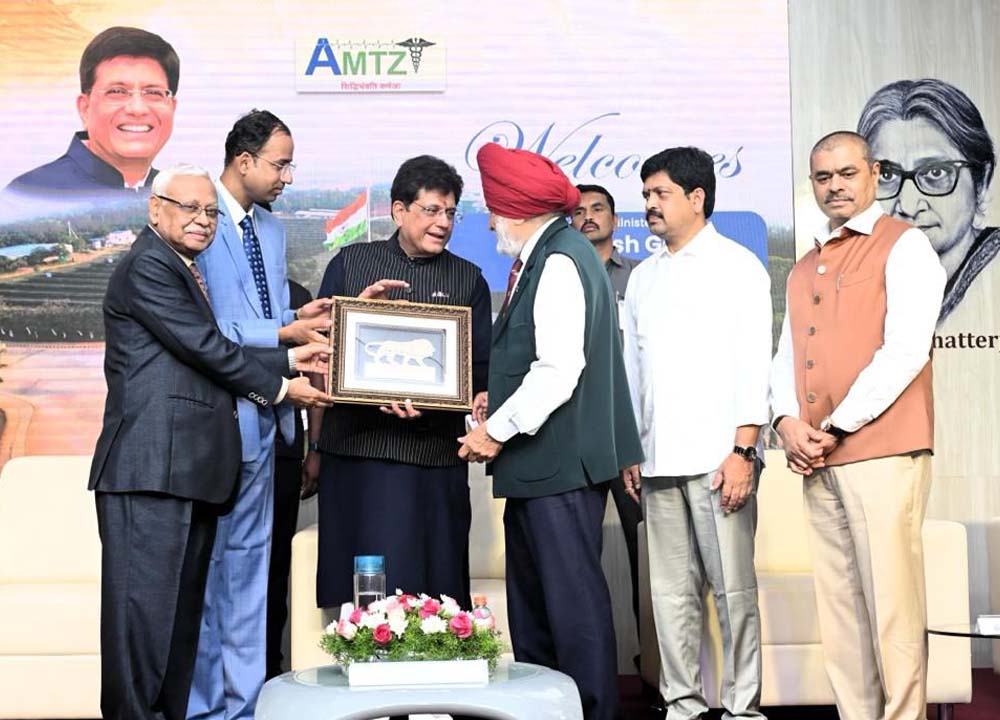VISAKHAPATNAM – In a landmark event for India’s healthcare self-reliance Piyush Goyal Union Minister of Commerce & Industry inaugurated two cutting-edge medical device manufacturing facilities at the Andhra Pradesh MedTech Zone (AMTZ) on November 15. The launch of an indigenous MRI manufacturing initiative 3i MedTech and a new CathLab production unit by Innovation Imaging Technologies (IITPL) marks a strategic shift from import dependency to domestic innovation in high-end medical technology.
The inaugurations at the 270-acre AMTZ campus one of the world’s largest integrated medical device parks signal India’s growing capability to produce sophisticated, life-saving diagnostic equipment within its own borders.
A Strategic Push for “Make in India” in MedTech
The establishment of 3i MedTech represents India’s bold entry into the complex domain of MRI manufacturing. Developed in collaboration with AMTZ the initiative aims to deliver advanced, precise and more affordable Magnetic Resonance Imaging (MRI) systems tailored to patient needs.
Simultaneously, the new CathLab manufacturing facility by IITPL strengthens India’s capacity to produce crucial cardiac imaging systems used in life-saving angioplasty and other heart procedures. This move is pivotal in reducing the nation’s heavy reliance on imported cath labs, which are critical for modern cardiology.
Leadership and a Unique Ecosystem Praised
During his visit, Minister Goyal praised Dr. Jitendra Sharma, Managing Director and CEO of AMTZ, for his visionary leadership in building a “globally competitive MedTech manufacturing ecosystem.” He expressed strong confidence that India’s MedTech sector is poised for accelerated growth, highlighting AMTZ’s unique model that successfully blends speed, cost-effectiveness, and deep technological innovation.
Dr. Sharma emphasized AMTZ’s mission to translate scientific research into market-ready, socially impactful medical products. He noted that AMTZ is the only MedTech cluster in the world to host both a WHO Centre and a World Trade Centre, underscoring its global recognition.
Forging Future Collaborations
The event also served as a platform for strategic partnerships, with several Memoranda of Understanding (MoUs) exchanged in the presence of Minister Goyal. These collaborations with institutions and industry bodies aim to strengthen skill development, industry-academia engagement, and financial support for MedTech innovators.
The event concluded with the ceremonial flag-off of an export consignment of Varex Detectors, symbolizing India’s evolving role from an importer to a producer and exporter of advanced medical technology components.
Frequently Asked Questions (FAQ)
1. What is AMTZ?
The Andhra Pradesh MedTech Zone (AMTZ) is a dedicated 270-acre industrial park in Visakhapatnam designed to be a one-stop solution for medical device manufacturing. It hosts over 150 companies and provides shared infrastructure for R&D, testing, and production.
2. What is the significance of launching indigenous MRI and CathLab manufacturing?
MRIs and CathLabs are high-value, complex medical devices that India has historically imported. Local manufacturing reduces costs, increases accessibility for hospitals, enhances service speed, and is a major step towards the ‘Atmanirbhar Bharat’ (Self-Reliant India) goal in the critical healthcare sector.
3. What are 3i MedTech and IITPL?
3i MedTech is a new initiative launched at AMTZ focused on designing and manufacturing MRI machines in India.
IITPL (Innovation Imaging Technologies Pvt Ltd) is a company that has established a new production facility at AMTZ to manufacture CathLabs domestically.
4. Why is AMTZ considered unique globally?
AMTZ is the only MedTech cluster in the world to host both a World Health Organization (WHO) Centre and a World Trade Centre, giving it unparalleled global credibility and strategic importance for international collaboration and market access.
5. How does this benefit the common citizen?
Indigenous manufacturing leads to more affordable medical scans and procedures. It also creates a more resilient supply chain, ensuring that critical medical equipment is available without being subject to global supply disruptions, ultimately improving healthcare outcomes across the country.


